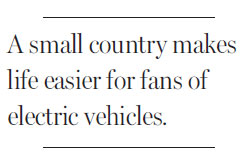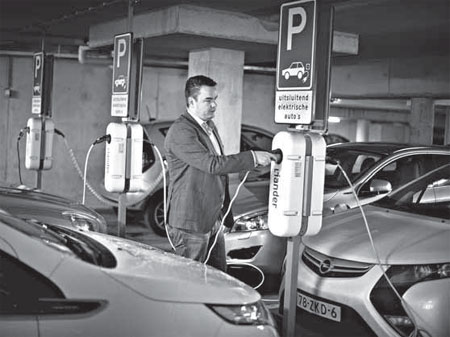Plugging in, Dutch put electric cars to the test
Updated: 2013-03-03 08:04
By Elisabeth Rosenthal(The New York Times)
|
|||||||
|
The Netherlands is expanding a grid of electric-car charging stations to lessen drivers' anxiety about running out of power. Ilvy Njiokiktjien for The New York Times |

AMSTERDAM - If electric vehicles catch on anywhere, it should be in the Netherlands: a small country - about 160 kilometers east to west - with gas prices of about $2.30 a liter and a long tradition of environmental activism.
To encourage electric driving, the country is developing a rapidly expanding national grid of charging stations in cities and along highways. With hefty tax breaks, promotional leases and cheaper operating costs, the vehicles offer driving costs no higher than those of conventional cars, some analysts say.
Last year 120,000 plug-in electric vehicles were sold globally, according to Pike Research, an industry analyst group, which predicts 40 percent annual growth between now and 2020.
The number of plug-in electric vehicles in the Netherlands soared eightfold to about 7,500 last year. "In a few countries you're starting to see a number of E.V.'s on the road, especially in capital cities; they're very visible," said Peder Jensen, a transportation expert at the European Environment Agency.
And yet, experiments in the Netherlands and Denmark also underscore the challenges facing this new technology. Sales have been lower than politicians and automakers hoped, representing under 1 percent of new vehicles, even here. "It seems that the industry has not convinced consumers that they can do this," Mr. Jensen said.
Though many analysts had assigned electric vehicles to the second-car niche, a 2012 survey of Dutch drivers of the cars found that most of them ended up used as the primary vehicle.
Over time, drivers overcame what has been dubbed as "range anxiety," learning where to find charging points - a smartphone app contains them all.
"There's still some planning; it's a bit like a puzzle," said Maarten Noom, a management consultant who drives an electric vehicle. "It's not the same ease of mind as with a gas car."
Mr. Noom, for example, charges at his office and overnight at home, but he switches to a gasoline car when his appointments are scattered around the Netherlands. Charging at home uses low voltage and takes four to eight hours. New high-voltage rapid charging stations give an 80 percent charge in 20 to 30 minutes, but they are costly to install and still rare.
Many experts say the lack of a uniform business model in the fledgling market is also a hindrance. Contracts for charging are sometimes purchased along with the car and tied to a particular charging network, much as cellphones are linked to a certain carrier. What is more, the penetration of the various networks varies depending on the region, and technology is not always interchangeable.
"There's a Wild West feel, with a lot of companies jumping in," said Mike Omotoso, a senior manager of forecasting at LMC Automotive. "But ultimately there will be a shakeout and consolidation."
Mr. Jensen said that a big infusion of money could be needed to improve infrastructure in countries seeking to increase the use of electric vehicles.
When he looked into buying an electric car, the charging system would not fit in his garage, Mr. Jensen said, and few are willing to drive around Europe with a trunk full of adapters. "I think the companies who will win are not necessarily the ones that have the best technology, but the ones that form the best alliances," he said. "If you have a mobile phone - and even more a car - the most important thing is that you can use it wherever you go."
The New York Times
(China Daily 03/03/2013 page10)
